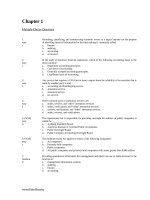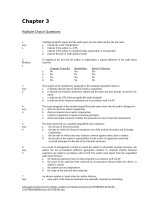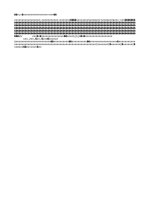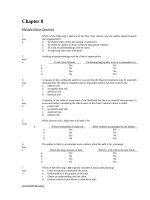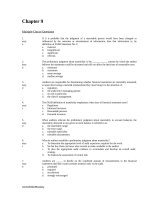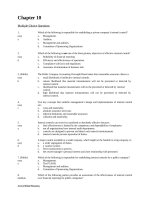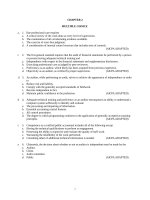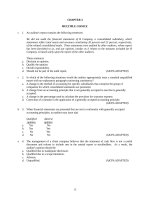Test bank auditing and assurance principles by arens, elder beasley chapter 18
Bạn đang xem bản rút gọn của tài liệu. Xem và tải ngay bản đầy đủ của tài liệu tại đây (94.44 KB, 19 trang )
Chapter 18
Multiple-Choice Questions
1.
easy
d
The classes of transactions in the acquisition and payment cycle include acquisition of:
a. goods.
b. goods and services.
c. goods and services, and cash disbursements.
d. goods and services, cash disbursements, and purchase returns and allowances.
2.
easy
c
The overall objective in the audit of the acquisition and payment cycle is:
a. to ensure the reliability of the affected accounts.
b. to ensure the accuracy of the affected accounts.
c. to evaluate whether the affected accounts are fairly stated in accordance with GAAP.
d. to evaluate whether fraudulent payments were made.
3.
The audit of the acquisition and payment cycle often takes ____ time to audit than other
cycles.
a. less
b. about the same
c. more
d. no less
easy
c
4.
easy
a
What typically initiates the acquisitions and payment cycle?
a. Issuance of a purchase requisition or request for purchase of goods/services.
b. Issuance of payment to vendor.
c. Approval of a new vendor.
d. Purchase requisition.
5.
easy
b
What typically ends the acquisitions and payment cycle?
a. Issuance of a purchase requisition or request for purchase of goods/services.
b. Issuance of a payment to a vendor.
c. Approval of a new vendor.
d. Purchase requisition.
6.
easy
b
The receipt of goods and services in the normal course of business represents the date clients
normally recognize:
a. income.
b. the liability.
c. warranty assets.
d. expenses.
7.
easy
c
Which of the following accounts is not included in the acquisitions class of transactions?
a. Inventory.
b. Prepaid expenses.
c. Purchase discounts.
d. Accounts payable.
Arens/Elder/Beasley
8.
easy
a
A document indicating a reduction in the amount owed to a vendor because of returned
goods is:
a. a debit memo.
b. a credit memo.
c. a receiving room report.
d. a shipping room report.
9.
easy
a
A document used by organizations to establish a formal means of recording and controlling
acquisitions which usually contains a package of documents about the acquisition is the:
a. voucher.
b. purchase order.
c. receiving report.
d. purchase requisition.
10.
easy
d
The accounts payable account includes obligations for the acquisition of:
a. raw materials.
b. equipment.
c. utilities.
d. all three of the above.
11.
easy
d
Comparing expenses to prior years is an effective analytical procedure for accounts payable
because expenses from year to year are:
a. erratic.
b. variable.
c. dynamic.
d. relatively stable.
12.
The overall objective in the audit of accounts payable is to determine whether accounts
payable:
a. is fairly stated and properly disclosed.
b. is overstated.
c. is understated.
d. is accurately stated.
easy
a
13.
easy
c
At what point do most companies recognize liabilities in the acquisition and payment cycle?
a. The issuance of a purchase order.
b. Receipt of acknowledgement of order by vendor.
c. Receipt of goods or services.
d. The receipt of a vendor statement.
14.
easy
a
The computer-generated file which records acquisitions, disbursements and allowances for
each vendor is the
a. Accounts payable master file
b. Cash disbursements file.
c. Acquisitions transaction file.
d. Purchase approval file.
15.
The is a computer-generated file that includes all acquisition transactions during a given
period is the
a. Accounts payable file
b. Cash disbursements file.
c. Acquisitions transaction file.
d. Purchase approval file.
easy
c
Arens/Elder/Beasley
16.
medium
c
The major balance sheet account in the acquisition and payment cycle is:
a. Notes payable.
b. Accruals payable.
c. Accounts payable.
d. Accrued liabilities.
17.
medium
d
Which of the following business functions is not considered to be part of the acquisitions
class of transactions?
a. Processing purchase orders.
b. Recognizing liabilities.
c. Receiving goods and services.
d. Processing cash disbursements.
18.
It usually takes more time to audit the acquisition and payment cycle than other cycles
because:
a. there is a greater possibility of fraud in these transactions.
b. internal controls in this area are usually the weakest.
c. of the large number of accounts affected.
d. there is a greater likelihood of lawsuits against the CPA relating to these accounts.
medium
c
19.
medium
a
A written purchase order is a legal document that is:
a. an offer to buy.
b. not enforceable if it is not in writing.
c. a binding agreement between purchaser and vendor.
d. an acceptance of a vendor’s catalog offer to sell.
20.
medium
d
For good internal control, the purchasing department should not be responsible for:
a. finding the lowest cost vendor.
b. reviewing vendors’ catalog descriptions and prices for standardized items.
c. designing the purchase order form.
d. authorizing the acquisition of goods.
21.
medium
c
The accounts payable department usually has responsibility for verifying the propriety of
acquisitions by comparing the details on the:
a. vendor’s invoice and the receiving report.
b. vendor’s invoice and the purchase requisition.
c. purchase order, receiving report, and vendor’s invoice.
d. purchase requisition, purchase order, and receiving report.
22.
medium
d
Tests of controls for the acquisition and payment cycle are usually divided into:
a. tests of acquisitions and classification.
b. tests of authorization and acquisition.
c. tests of authorization and disbursement.
d. tests of acquisitions and disbursements.
Arens/Elder/Beasley
23.
medium
b
Many companies do not maintain an accounts payable master file by vendor. These
companies pay on the basis of:
a. vendors’ monthly statements.
b. individual vendors’ invoices.
c. the accounts payable account in the general ledger.
d. dunning letters.
24.
medium
d
An important control in the accounts payable and IT departments is to ensure that those
personnel who record acquisitions do not have access to:
a. vendors’ price lists.
b. the accounts payable master file.
c. lists of vendors’ names and addresses.
d. cash, marketable securities, and other easily convertible assets.
25.
medium
b
Which of the following is not a key control in the acquisition and payment cycle?
a. Authorization of purchases.
b. Authorization of credit.
c. Timely recording and independent review of transactions.
d. Authorization of payments.
26.
medium
c
Proper authorization for acquisition is essential because it:
a. ensures that goods/services are used efficiently by company employees.
b. ensures that goods/services were purchased from approved vendors.
c. ensures that goods/services are for authorized company purposes.
d. ensures that goods/services were purchased at the lowest possible price.
27.
medium
b
Which department should initiate a report when goods arrive from a vendor?
a. Manufacturing
b. Receiving
c. Accounting
d. Treasury
28.
medium
a
After a purchase requisition is approved, a _________ must be initiated to purchase the
goods or services.
a. purchase order
b. vendor order
c. call order
d. vendor invoice
29.
medium
b
When a client uses perpetual inventory records, the tests of details of balances for inventory
can be significantly reduced if the auditor believes the records are accurate. The controls
over the acquisitions included in the records are normally tested as a part of the:
a. tests of controls.
b. tests of controls and tests of transactions.
c. tests of details of balances.
d. analytical procedures and tests of controls.
30.
medium
c
Which of the following acquisition transactions is likely to be covered by a general
authorization by company policy?
Arens/Elder/Beasley
a.
b.
c.
d.
Purchase of office equipment
maintenance services
Yes
No
Yes
No
Purchase of office buildings for company
use
Yes
No
No
Yes
31.
medium
b
The auditor’s internal control objective to determine that “recorded acquisitions are for
goods and services received” satisfies the audit objective of:
a. accuracy.
b. occurrence.
c. authorization.
d. completeness.
32.
medium
d
Failure to record the acquisition of goods is a violation of which audit objective?
a. Accuracy
b. Occurrence
c. Authorization
d. Completeness
33.
medium
a
Once the auditor has decided on the specific procedures, the acquisitions tests and the cash
disbursements tests are typically performed:
a. concurrently.
b. sequentially.
c. independently.
d. separately.
34.
medium
c
The internal control that requires that “checks are prenumbered and accounted for” satisfies
the objective of:
a. accuracy.
b. existence.
c. completeness.
d. posting and summarization.
35.
medium
b
The most important controls over cash disbursements include all but which of the following?
a. Signing of checks by an authorized employee.
b. Random examination of the supporting documents by the authorized check signer
before signing checks.
c. Separation of responsibilities for signing the checks and performing the accounts
payable function.
d. Prenumbering of checks and investigations of missing checks.
36.
medium
c
Because of the importance of tests of controls and substantive tests of transactions for
acquisitions and cash disbursements, it is common in this audit area to use:
a. block sampling.
b. variables sampling.
c. attributes sampling.
d. probability proportional to size sampling.
37.
medium
a
Because many of the types of errors and irregularities that may be found in the acquisition
and payment cycle represent a misstatement of earnings and are of significant concern to the
auditor, the tolerable exception rate selected by the auditor will be:
a. low.
Arens/Elder/Beasley
b.
c.
d.
Arens/Elder/Beasley
high.
average.
very high.
38.
medium
c
The main focus taken by the auditor in verifying liability balances is on the discovery of:
a. understated liabilities.
b. overstated liabilities.
c. understated or omitted liabilities.
d. overstated or extraneous liabilities.
39.
medium
c
Which of the following tests of controls is least useful in assessing the transaction-related
audit objective related to occurrence?
a. Examine documents in voucher package for occurrence.
b. Examine supporting documents for indication of approval.
c. Account for sequence of vouchers.
d. Attempt to input transactions with valid and invalid vendors.
40.
medium
a
The test of details of balances procedure to “trace from account payable list to vendors’
invoices and statements” satisfies the objective of:
a. occurrence.
b. completeness.
c. classification.
d. detail tie-in.
41.
medium
b
By tracing receiving reports issued at and before year-end to vendors’ invoices and making
sure they are included in accounts payable, the auditor is testing for:
a. theft of merchandise by employees.
b. unrecorded obligations.
c. lapping.
d. kiting.
42.
medium
b
The extent of a search for unrecorded liabilities largely depends on:
a. materiality and inherent risk.
b. materiality and control risk.
c. materiality only.
d. inherent risk only.
43.
A failure to record acquisitions of goods most likely will affect all but which of the
following?
a. Accounts payable.
b. Net income.
c. Retained earnings.
d. Cash.
medium
d
44.
medium
d
When the client’s physical inventory occurs before the last day of the year, it is still
necessary to perform an accounts payable cutoff at the time of the count. In addition, the
auditor must verify whether all acquisitions taking place between the count and the end of
the year were added to:
a. the physical inventory.
b. Accounts Payable.
c. Accounts Payable and Cost of Goods Sold.
d. the physical inventory and Accounts Payable.
45.
medium
a
When the auditor uses sampling to examine transactions in the acquisition and payment
cycle, the tolerable exception rate is typically set at a(n) _______ level.
a. low.
b. medium.
c. high.
d. indeterminate.
46.
medium
Which of the following is most reliable for verifying the correct balance of accounts payable?
a. Vendors’ invoices.
Arens/Elder/Beasley
c
b.
c.
d.
47.
medium
b
Vendors’ statements and vendors’ invoices are both relatively reliable evidence because they:
a. come directly to the auditor without being in client’s possession.
b. originate from a third party.
c. validate the effectiveness of the control system.
d. are compared to and reconciled with sales invoices.
48.
medium
c
For effective internal control, the accounts payable department should compare the
information on each vendor’s invoice with the:
a. receiving report and the voucher.
b. vendor’s packing slip and the voucher.
c. receiving report and the purchase order.
d. vendor’s packing slip and the purchase order.
49.
medium
b
Which of the following is the most effective control procedure to detect vouchers that were
prepared for the payment of goods that were not received?
a. Count goods upon receipt in storeroom.
b. Match purchase order, receiving report, and vendor’s invoice for each voucher in
accounts payable department.
c. Compare goods received with goods requisitioned in receiving department.
d. Verify vouchers for accuracy and approval in internal audit department.
50.
medium
c
Cutoff information for inventory acquisitions should be obtained during:
a. the interim period prior to year-end.
b. the interim period immediately following year-end.
c. the physical observation of inventory.
d. either the interim period prior to or immediately following year-end..
51.
medium
d
Assume that during cutoff testing you determined that the last receiving report number for
inventory was 24986. Which of the following receiving report numbers would you not expect
to be included in inventory and accounts payable at year-end?
a. 24980
b. 19773
c. 23019
d. 24990
52.
medium
b
Auditor confirmation of accounts payable balances at the balance sheet date may be
unnecessary because:
a. this is a duplication of cutoff tests.
b. there is likely to be other reliable external evidence available to support the balances.
c. accounts payable balances at the balance sheet date may not be paid before the audit is
completed.
d. correspondence with the audit client’s attorney will reveal all legal action by vendors
for nonpayment.
Arens/Elder/Beasley
Vendors’ statements.
Confirmations.
Bills of lading.
53.
medium
c
Under which of the following circumstances would it be advisable for the auditor to confirm
accounts payable with creditors?
a. Internal accounting control over accounts payable is adequate, and there is sufficient
evidence on hand to minimize the risk of a material misstatement.
b. Confirmation response is expected to be favorable, and accounts payable balances are of
immaterial amounts.
c. Creditor statements are not available and internal control over payables is
unsatisfactory.
d. The majority of accounts payable balances are with associated companies.
54.
medium
b
Internal control is strengthened when the quantity of merchandise ordered is omitted from
the copy of the purchase order sent to the:
a. department that initiated the requisition.
b. receiving department.
c. purchasing agent.
d. accounts payable department.
55.
medium
a
Which of the following should sign checks under conditions of effective internal control?
a. Treasurer.
b. Purchasing agent.
c. Accounts payable clerk.
d. Person preparing the checks.
56.
medium
a
Which of the following is an effective internal accounting control over cash payments?
a. Signed checks should be mailed under the supervision of the check signer.
b. Spoiled checks that have been voided should be disposed of immediately.
c. Checks should be prepared only by persons responsible for cash receipts and
disbursements.
d. A check-signing machine with two signatures should be used.
57.
challenging
a
When assets are being verified, auditors focus much of their attention on making sure that the
accounts are not overstated. Alternatively, auditors focus their efforts on understatement
when auditing liabilities. What is the primary reason for this difference in focus?
a. Auditors’ legal liability.
b. GAAP.
c. GAAS requirements.
d. All of the above.
58.
challenging
d
Internal controls that are likely to prevent the client from including as a business expense
those transactions that primarily benefit management or other employees rather than the
entity being audited satisfy the control objective that:
a. acquisitions are correctly valued.
b. existing acquisitions are recorded.
c. acquisitions are correctly classified.
d. recorded acquisitions are for goods and services received.
59.
challenging
d
A company failed to record an acquisition of merchandise and its related liability, but the
merchandise was included in ending inventory. The effect on the financial statements was to:
a. understate both assets and liabilities.
b. understate net income and owners’ equity.
c. understate assets and owners’ equity.
d. understate liabilities, and overstate both net income and owners’ equity.
Arens/Elder/Beasley
60.
challenging
b
The test of transactions which requires one to “reconcile recorded cash disbursements with
the cash disbursements on the bank statement” satisfies the objective of:
a. occurrence.
b. completeness.
c. accuracy.
d. posting and summarization.
61.
challenging
d
Which of the following statements is false?
a. The ownership objective is an important part of verifying assets but not liabilities.
b. In auditing liabilities, the emphasis is on the search for understatements rather than
overstatements.
c. Because of the emphasis on understatements in liability accounts, out-of-period liability
tests are important for accounts payable.
d. The success of the auditor’s search for unrecorded liabilities is not dependent upon the
materiality of the potential balance in the account.
62.
challenging
c
The purpose of the audit procedure to “examine underlying documentation for subsequent
cash disbursements” is to:
a. uncover liabilities on the balance sheet which should not have been recorded until a
subsequent period.
b. find the documentation relating to a cash disbursement.
c. uncover payments made in a subsequent accounting period for liabilities that existed at
the balance sheet date.
d. uncover cash disbursements recorded in a subsequent accounting period which should
be recorded in this period.
63.
challenging
a
To test for cutoff errors which overstate liabilities, the auditor should trace, to vendors’
invoices, the receiving reports issued:
a. after year-end.
b. before year-end.
c. the last day of the fiscal year.
d. both before and after year-end.
64.
challenging
c
In determining that the accounts payable cutoff is correct, it is essential that the cutoff tests
be coordinated with the:
a. confirmation of payables.
b. tests on long-term liabilities.
c. observation of inventory.
d. cash count.
65.
challenging
a
An inventory acquisition is received late in the afternoon of December 31 after the physical
inventory is completed. If the acquisition is included in accounts payable and purchases, but
excluded from inventory, the result:
a. is an understatement of net earnings.
b. is an overstatement of net earnings.
c. is an overstatement of working capital.
d. is an overstatement of owner’s equity.
Arens/Elder/Beasley
66.
challenging
b
When an acquisition is on an FOB origin basis, the inventory and related accounts payable
must be recorded in the current period if the goods were:
a. received prior to the balance sheet date.
b. shipped prior to the balance sheet date.
c. both shipped and received prior to the balance sheet date.
d. paid for in advance.
67.
challenging
a
The auditor gets highly reliable evidence about individual transactions by examining:
a. vendors’ invoices.
b. vendors’ statements.
c. confirmations of accounts payable balances.
d. detailed inventory counting instructions.
68.
Which of the following documents is best for verifying the correct balance in accounts
payable?
a. Bills of lading.
b. Confirmations.
c. Vendors’ invoices.
d. Vendors’ statements.
challenging
d
69.
challenging
c
When goods are received, the receiving clerk should match the goods with the:
a. purchase order and the requisition form.
b. vendor’s invoice and the receiving report.
c. vendor’s shipping document and the purchase order.
d. receiving report and the vendor’s shipping document.
70.
challenging
c
For effective internal control purposes, the vouchers payable department generally should:
a. obliterate the quantity ordered on the receiving department copy of the purchase order.
b. stamp, perforate, or otherwise cancel supporting documentation after payment is
mailed.
c. establish the agreement of the vendor’s invoice with the receiving report and purchase
order.
d. ascertain that each requisition is approved as to price, quantity, and quality by an
authorized employee.
71.
challenging
b
An auditor performs a test to determine whether all merchandise for which the client was
billed was received. The population for this test consists of all:
a. merchandise received.
b. vendors’ invoices.
c. canceled checks.
d. receiving reports.
72.
challenging
c
Matching the supplier’s invoice, the purchase order, and the receiving report normally should
be the responsibility of the:
a. warehouse receiving function.
b. purchasing function.
c. general accounting function.
d. treasury function.
Arens/Elder/Beasley
73.
challenging
a
A CPA learns that his client has paid a vendor twice for the same shipment, once based upon
the original invoice and once based upon the monthly statement. A control procedure that
should have prevented this duplicate payment is:
a. attachment of the receiving report to the disbursement report.
b. prenumbering of disbursement vouchers.
c. use of a limit or reasonableness test.
d. prenumbering of receiving reports.
74.
challenging
c
With respect to a small company’s system of purchasing supplies, an auditor’s primary
concern should be to obtain satisfaction that supplies ordered and paid for have been:
a. requested by and approved by authorized individuals who have no incompatible duties.
b. used in the course of business and solely for business purposes during the year under
audit.
c. received, counted, and checked to quantities and amounts on purchase orders and
invoices.
d. properly recorded as assets and systematically amortized over the estimated useful life
of the supplies.
Essay Questions
75.
easy
Tests of controls and tests of transactions for the acquisition and payment cycle are normally
divided into two broad areas. What are these areas?
Answer:
Tests of controls and tests of transactions are usually divided into tests of acquisitions
and tests of payments.
76.
easy
Describe vouchers and their purposes.
Answer:
A voucher is often used to establish a formal means of recording and controlling
acquisitions. Vouchers typically include a cover sheet or folder for containing
documents and a package of supporting documents such as the purchase order, packing
slip, receiving report and vendor invoice. Companies may also include a copy of the
check in the voucher package after payment is made.
77.
medium
What are the three important controls over cash disbursements?
Answer:
• Signing of check by an individual with proper authority.
• Separation of responsibilities for signing checks and performing the accounts
payable function.
• Careful examination of supporting documents by the check signer at the time the
check is signed.
Arens/Elder/Beasley
78.
medium
Discuss each of the four business functions that comprise the acquisition and payment cycle.
79.
medium
Discuss the key internal controls that should be present in the processing purchase orders
function in the acquisitions and payment cycle.
Answer:
The four business functions that comprise the acquisition and payment cycle are:
• Processing purchase orders. This function involves the preparation of a purchase
requisition and a purchase order to acquire goods and services.
• Receiving goods and services. When goods are received, a receiving report is
prepared that indicates the description of goods, the quantity received, the date
received, and other relevant data.
• Recognizing the liability. In most companies, the liability for acquisitions is
recognized when the goods and services are received; in other companies, it is
deferred until the vendor’s invoice is received.
• Processing and recording cash disbursements. This function involves the signing
and mailing of the check for payment of the acquisition and recording of the cash
disbursement in the cash disbursements journal.
Answer:
Proper authorization, both general and specific, for acquisition transactions is an
essential internal control of the processing purchase orders function. A purchasing
department that is independent of the authorization or receiving functions is often
established by companies to ensure an adequate quantity of goods and services at a
minimum price. Purchase orders should be prenumbered and should include sufficient
columns and spaces to minimize the likelihood of unintentional omissions on the form
when goods are ordered.
80.
medium
Discuss the key internal controls that should be present in the receiving goods and services
function in the acquisitions and payment cycle.
Answer:
For good internal control over the receiving goods and services function, most
companies require that the receiving department prepares a receiving report when goods
are received, one copy of which is sent to the storeroom and another to the accounts
payable department. To prevent theft, it is important that the goods be physically
controlled from the time of their receipt until their disposal. The personnel in the
receiving department should be independent of the storeroom personnel and the
accounting department. In addition, the accounting records should transfer
responsibility for the goods as they are transferred from receiving to storage and from
storage to manufacturing.
81.
medium
How do auditors determine the extent of testing of internal controls in the acquisition and
payment cycle?
Answer:
When auditors intend to rely on controls to support a preliminary control risk below
maximum, the auditor performs tests of controls to obtain evidence that controls are
operating effectively. As the operating effectiveness improves, the auditor is able to
reduce substantive tests. If the company is public, then the auditor must document and tests
controls sufficiently to issue an opinion on internal control.
Arens/Elder/Beasley
82.
medium
Discuss the key internal controls that should be present in the “recognizing the liability”
function in the acquisitions and payment cycle.
Answer:
Key internal controls over the recognizing the liability function in the acquisitions and
payment cycle include requiring the accounts payable department to verify the
propriety of acquisitions by comparing the details on the purchase order, receiving
report, and vendor’s invoice to determine that the descriptions, prices, quantities, terms,
and freight on the vendor’s invoice are correct. In addition, personnel who record
acquisitions should not have access to cash, marketable securities, and other assets.
There should also be adequate documents and records, proper procedures for
recordkeeping, and independent checks on performance.
83.
medium
Describe purchase requisitions and purchase orders. What is a key difference between the
two documents?
Answer:
Purchase requisitions represent requests for goods and services by an authorized
employee. Requisitions may originate from any authorized company employee such as a
storeroom supervisor or manufacturing manager. Purchase orders are documents that
identify the description, quantity, and other related information for goods or services
that the company is purchasing. Unlike requisitions, purchase orders are directed to
specific vendors.
84.
medium
Describe the methodology for designing tests of details of balances for accounts payable.
85.
medium
Explain why the confirmation of accounts payable is less common than confirmation of
accounts receivable.
Answer:
The methodology for designing tests of accounts payable consists of:
1. Set materiality and assess acceptable audit risk and inherent risk for accounts
payable.
2. Assess control risk for accounts payable.
3. Design and perform tests of controls and substantive tests of transactions for the
acquisition and payment cycle.
4. Design and perform analytical procedures for the acquisition and payment cycle.
5. Design tests of details of accounts payable balance to satisfy balance-related audit
objectives. Decide audit procedures to perform, sample size, items to select, and
timing of tests.
Answer:
Confirmation of accounts payable is less common than confirmation of accounts
receivable because of the availability of vendors’ statements and vendors’ invoices,
which are both relatively reliable evidence, when auditing accounts payable.
Arens/Elder/Beasley
86.
medium
Discuss the circumstances in which it is desirable to send confirmation requests to the
client’s vendors.
Answer:
It is desirable to send confirmation requests to the client’s vendors when the client’s
internal controls are weak, when vendors’ statements are not available, or when the
auditor questions the client’s integrity.
87.
challenging
Discuss the difference in the auditor’s approach to the audit of assets and the audit of
liabilities.
Answer:
The audit of assets is primarily focused on overstatements. The existence of assets is
verified via confirmation, physical examination, and examination of supporting
documents. On the other hand, the auditor’s approach in verifying liabilities is to focus
on understatement. The difference in the auditor’s approaches is primarily driven by the
auditor’s legal liability.
88.
challenging
Describe the audit procedures typically used to test for out-of-period liabilities (also referred
to as the search for unrecorded accounts payable).
Answer:
The audit procedures typically used to test for out-of-period liabilities are:
• Examine underlying documentation for subsequent cash disbursement.
• Examine underlying documentation for bills not paid several weeks after the yearend.
• Trace receiving reports issued before year-end to related vendors’ invoices.
• Trace vendors’ statements that show a balance due to the accounts payable trial
balance.
• Send confirmations to vendors with which the client does business, including zero
balance confirmations.
Arens/Elder/Beasley
Other Objective Answer Format Questions
89.
medium
Match seven of the terms for documents and records (a-m) used in the acquisitions and cash
disbursement cycle with the descriptions provided below (1-7):
a.
b.
c.
d.
e.
f.
g.
h.
i.
j.
k.
l.
m.
Purchase requisition
Purchase order
Receiving report
Acquisitions journal
Summary acquisitions report
Vendor’s invoice
Debit memo
Voucher
Accounts payable master file
Accounts payable trial balance
Vendor’s statement
Check
Cash disbursements journal
g
1.
A document indicating a reduction in the amount owed to a vendor because of
returned goods or an allowance granted.
f
2.
A document that specifies the details of an acquisition transaction and amount
of money owed to the vendor for an acquisition.
b
3.
A document prepared by the purchasing department indicating the description,
quantity, and related information for goods and services that the company
intends to purchase.
j
4.
A listing of the amount owed to each vendor at a point in time.
h
5.
A document used to establish a formal means of recording and controlling
acquisitions; it includes a cover sheet and a package of relevant documents.
a
6.
A document used to request goods and services by an authorized employee.
m
7.
The listing or report that includes all cash payments for a given period.
90.
easy
b
A vendor’s statement is unreliable and auditors rarely use it.
a. True
b. False
91.
easy
b
The acquisition and payment cycle consists of one class of transactions.
a. True
b. False
92.
easy
b
The cash account is not part of the acquisitions and payment cycle.
a. True
b. False
Arens/Elder/Beasley
93.
easy
b
The acquisition and payment cycle is highly controlled and not well-structured in most
companies.
a. True
b. False
94.
easy
a
Most companies recognize a liability when the goods are received by the company.
a. True
b. False
95.
medium
b
The acquisition and payment cycle typically begins with the initiation of a purchase order.
a. True
b. False
96.
medium
b
A bill of lading is normally prepared at the time tangible goods are received and indicates the
description of goods, the quantity received, the date received, and other relevant data.
a. True
b. False
97.
medium
b
A document received from the vendor indicating such things as the description and quantity
of goods and services received, price including freight, cash discount terms, and date of
billing is called the voucher.
a. True
b. False
98.
medium
b
When auditing the acquisitions and cash disbursements cycle, it is usually more efficient for
the auditor to reduce the extent of tests of controls and substantive tests of transactions and
focus primarily on tests of details of balances, especially when the client has effective
internal controls.
a. True
b. False
99.
medium
a
Failure to record the acquisition of goods and services directly affects the balance in
Accounts payable and may result in an overstatement of net income and owners’ equity.
a. True
b. False
100.
medium
a
If tests of controls and substantive tests of transactions related to perpetual inventory records
reveal controls over perpetuals are effective, the auditor is justified in reducing the extent of
tests of details of inventory.
a. True
b. False
101.
medium
a
Because of the importance of tests of controls and substantive tests of transactions for
acquisitions and cash disbursements, attributes sampling is commonly used when testing the
acquisitions and cash disbursements cycle.
a. True
b. False
102.
medium
a
The balance-related audit objective realizable value is not applicable when auditing Accounts
payable.
a. True
b. False
Arens/Elder/Beasley
103.
medium
b
When auditing Accounts payable, the auditor is more concerned about the possibility of
overstatements than understatements.
a. True
b. False
104.
medium
b
Examining documents for evidence of internal verification is not effective for evaluating the
transaction-related audit objective of timing.
a. True
b. False
105.
medium
a
A substantive test of transactions commonly used to test the completeness objective for
acquisitions is “Trace from a file of receiving reports to the acquisitions journal.”
a. True
b. False
106.
medium
a
The audit procedure “Test clerical accuracy by footing the journals and tracing postings to
general ledger and to accounts payable and inventory master files” is used to test the posting
and summarization objective for acquisitions.
a. True
b. False
107.
challenging
a
Auditors are normally more concerned about violations of the completeness objective for
acquisitions than about violations of the occurrence objective for acquisitions.
a. True
b. False
108.
challenging
b
To test for overstatement cutoff amounts when auditing Accounts payable, the auditor should
trace receiving reports issued before year-end to related vendors’ invoices to make sure they
are not recorded as Accounts payable.
a. True
b. False
109.
challenging
a
Receiving reports are normally only used to document the receipt of goods and are not used
to document the receipt of services.
a. True
b. False
110.
challenging
a
When performing tests of controls or substantive tests of transactions for acquisitions,
vendors’ invoices are more useful than vendors’ statements.
a. True
b. False
111.
challenging
b
When verifying the correct balance in Accounts payable, vendors’ invoices are more useful
than vendors’ statements.
a. True
b. False
112.
challenging
a
Auditors primarily emphasize the understatement of liabilities in the audit of Accounts
payable because they are concerned about potential legal liability.
a. True
b. False
Arens/Elder/Beasley
113.
challenging
a
The use of statistical sampling is less common for the audit of Accounts payable than for
accounts receivable because it is more difficult to define the population and determine the
population size in accounts payable.
a. True
b. False
114.
challenging
b
The internal control “Vouchers are prenumbered and accounted for” relates most closely to
the occurrence objective for acquisitions.
a. True
b. False
115.
challenging
a
The audit procedure “Examine canceled check for authorized signature, proper endorsement,
and cancellation by the bank” is used to test the occurrence objective for cash disbursements.
a. True
b. False
Arens/Elder/Beasley
